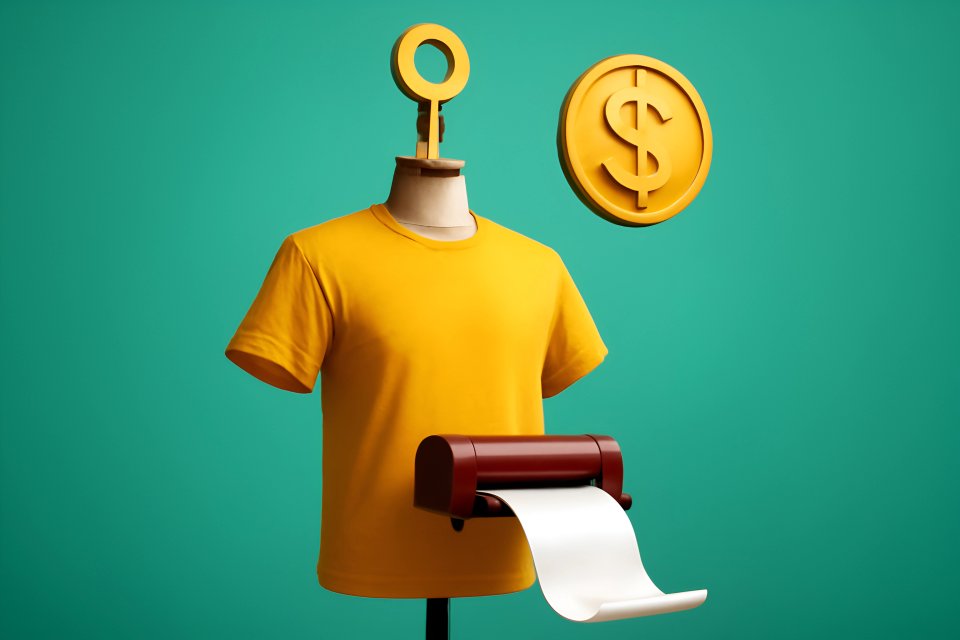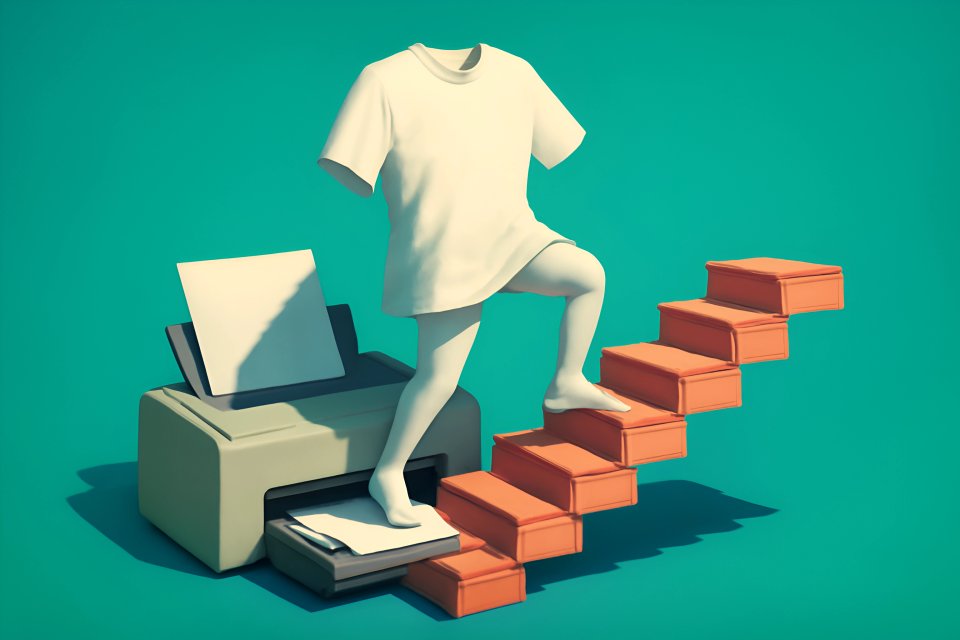
Introduction: Your Next Income Stream is Hiding in Your Content
You’ve done the hard work. You’ve poured your heart into your blog, built a loyal audience that hangs on your every word, and maybe you’re even seeing some revenue from ads and affiliate links. But you feel that nagging sense that there’s something more, a deeper connection you could forge, a more meaningful way to earn. What if you could stop just renting space on your own site and start building a real, tangible brand your readers can hold in their hands?
This is where Print-On-Demand (POD) enters the picture. Forget everything you think you know about selling merchandise. POD is a revolutionary business model where you create custom designs for products—like t-shirts, mugs, posters, and journals—that are only produced and shipped after a customer makes a purchase. There’s no warehouse full of unsold t-shirts, no risky upfront investment, and no logistical headaches.
For you, the niche blogger, this is the ultimate opportunity. It’s a powerful way to build a brand, not just a blog, and it’s one of the most creative forms of passive income for niche blogs available today. It’s just one of many powerful digital side hustles you can start to generate extra income online. In this guide, we’ll walk you through the entire process: from brainstorming product ideas your audience will crave to setting up the automated system that earns you money while you sleep.
Why Print-On-Demand is a Game-Changer for Niche Bloggers
This isn’t just about slapping a logo on a t-shirt. When you offer a product that speaks your community’s unique language, you’re giving them a badge of honor. It’s a way for your biggest fans to signal they are part of your tribe, transforming them from passive readers into active brand ambassadors. This deepens community loyalty in a way that a banner ad never could.
The beauty of the POD model is its incredible balance of low risk and high creative reward. You get to focus on the fun part—the ideas, the designs, the storytelling—while a partner company handles the heavy lifting of printing, packing, and shipping. Because there’s no inventory, it’s one of the best low-cost side hustles for generating passive income on a budget, allowing you to experiment endlessly without fear of financial loss.
Unlike intrusive pop-up ads or generic affiliate links, POD products feel authentic because they are a natural extension of your content. They add value instead of detracting from the user experience. Best of all, this creates true passive income potential. Once your shop is set up, a blog post you wrote two years ago can suddenly start generating sales today, tomorrow, and next year, creating a revenue stream that works for you long after you’ve hit “publish.”
The Foundation: How to Brainstorm Profitable POD Products Your Audience Will Actually Buy
The most successful products aren’t born from a flash of genius; they’re discovered by listening. What are the inside jokes, common phrases, or running gags that echo in your comment section? A knitting blog could sell a tote bag that says, I'd rather be knitting, while a blog for developers could sell a mug that reads, It's not a bug, it's a feature. These phrases tap into a shared identity.
Your most popular content is a goldmine of ideas. Dig into your analytics and find your top-performing posts. If an article on "Stoic Philosophy for Modern Life" consistently draws traffic, you have a built-in audience for mugs or journals featuring Marcus Aurelius quotes. According to Printful's own data, niche-specific designs that resonate with a dedicated community are far more successful than generic ones.
Go beyond novelty and think about solving a niche problem. What tool or accessory would make your audience’s life easier? A blog for freelance writers could sell a beautifully designed "Pitch Tracker" notebook. A blog for home cooks could offer branded aprons or magnetic kitchen conversion charts. Don’t limit yourself to t-shirts; think about mugs, tote bags, posters, phone cases, stickers, and hats to find the perfect fit for your audience.
The Action Plan: How to Monetize Your Niche Blog with Print-On-Demand in 5 Steps
Ready to turn those ideas into income? This is your roadmap. For a more granular walkthrough, you can also check out our step-by-step guide to starting a print-on-demand shop.
Step 1: Choose Your POD Partner
Your POD partner is the engine of your business, so choose wisely. The two biggest players are Printful and Printify. Printful is known for its premium quality and seamless integrations with platforms like WordPress and Shopify, while Printify often offers lower base costs by connecting you to a network of different printers. Your decision should be based on your priorities: ease of use, product catalog, profit margins, and shipping network.
Step 2: Create Your Designs (No Graphic Design Degree Required)
You don’t need to be a professional artist to create winning designs. User-friendly tools like Canva or Kittl are perfect for creating compelling text-based or simple graphic designs. For more complex ideas, you can hire affordable talent on platforms like Fiverr or Upwork, which is a smart investment for a signature product. The most important thing is to follow the technical specifications from your POD provider, ensuring your files are high-resolution (at least 300 DPI) and saved in the correct format for a crisp, professional print.
Step 3: Set Up Your Storefront
You have two main options for selling your products. The first is an integrated storefront using a plugin like WooCommerce on your WordPress blog, which creates a seamless shopping experience for your readers. The second, and often easier, option is a linked storefront, where you set up a shop on a platform like Etsy or Shopify and simply link to it from your blog’s navigation menu. While this sends traffic off-site, Shopify's platform is built to convert visitors into customers, making it a powerful choice.
Step 4: Price for Profit (and Value)
Calculating your price is straightforward. Use this simple formula to ensure you’re profitable on every sale:
\[POD Provider's Base Cost\] + \[Your Desired Profit\] = Retail PriceA typical t-shirt might have a base cost of $12. To achieve a 40% profit margin, you’d price it around $20. Remember to factor in any platform fees, but don’t be afraid to price based on value. An exclusive design offered only to your email subscribers can command a higher price because it offers a sense of scarcity and belonging.
Step 5: Order Samples
This step is non-negotiable. Before you promote a single product, you must order a sample to check the quality for yourself. How does the fabric feel? Are the colors as vibrant as they looked on screen? Does the print hold up after a wash? Holding the product in your hands is the only way to ensure you’re selling something you can be proud of, and it’s the foundation of building trust with your audience.
Smart Promotion: Effective Print-On-Demand Strategies for Bloggers
Creating great products is only half the battle; you need to market them effectively. Forget a lonely "Shop" link in your footer. The most successful bloggers weave their products directly into their content.
Strategy 1: Contextual Call-to-Actions
Don't just tell people you have a shop; show them. If you write an article about the perfect morning routine, include a high-quality photo of you using your branded coffee mug, with a direct link to buy it. This contextual promotion feels natural and helpful, not salesy. HubSpot notes that aligning marketing with user intent is key to digital success, and this strategy does exactly that.
Strategy 2: Create a "Merch Story" Post
Announce your new shop with a dedicated blog post that tells the story behind your creations. Why did you choose these designs? What do they represent about your community? Sharing this narrative transforms a simple transaction into a meaningful act of support.
Strategy 3: The "Founder" Model
Become your own best brand ambassador. Use your products in your daily life and share photos on social media. When your audience sees you wearing your own t-shirt or carrying your branded tote bag, it provides powerful social proof and makes the products infinitely more desirable. This is one of the most powerful print-on-demand strategies for beginners to build authenticity.
Strategy 4: Leverage Your Email List
Your email list is your most valuable asset. Reward your subscribers with an exclusive launch discount or early access to new designs. This not only drives a surge of initial sales but also reinforces their loyalty and makes them feel like true insiders.
Strategy 5: Add a "Shop" or "Merch" Tab to Your Main Navigation
Make it incredibly easy for visitors to find your products, no matter how they land on your site. A clear and prominent "Shop" or "Merch" tab in your main navigation menu ensures your store is always just one click away.
Case Studies: Niche Blogs Nailing POD Monetization
To see how this works in the real world, let's look at a few examples.
Case Study 1: "Vintage Voyager" (Travel Blog for History Buffs)
This blog taps into its audience's love for nostalgia by selling t-shirts with retro airline logos and high-quality posters of vintage travel ads. By embedding these products into articles about the "Golden Age of Travel," the blog has turned its passion for history into a significant revenue stream, proving that even highly specific niches can be profitable.
Case Study 2: "The Green Thumb Guide" (Urban Gardening Blog)
This blog sells witty "plant parent" mugs, tote bags perfect for a trip to the farmer's market, and branded gardening journals. They promote their products by using them in their tutorial videos, showing their audience how the items fit perfectly into the gardening lifestyle. This practical approach has led to a high repeat purchase rate.
Case Study 3: "Code & Coffee" (Developer Blog)
This blog monetizes programmer humor by selling laptop stickers with coding jokes and mugs that say "Syntax Error." They cleverly use their merchandise as prizes in free coding workshops, which not only builds goodwill but also converts workshop attendees into paying customers for their premium products.
Conclusion: Start Building Your Tangible Brand Today
Print-on-demand is more than just another income stream; it's a bridge between your digital content and the physical world. It’s a low-risk, high-reward method to monetize a niche blog by turning your audience's passion into a real product they can own and love. This is how you build a brand that lasts and unlock a truly passive income with print-on-demand.
Don't get overwhelmed by the details. Your first step isn't to build a store; it's to find one great idea. Open a notebook right now and brainstorm three product ideas your readers would genuinely love. That's where it all begins. And if you're inspired to keep exploring, you can also learn how to find other niche side hustles for consistent income.
What's your blog niche, and what's one POD product you could create for it? Share your ideas in the comments below

















